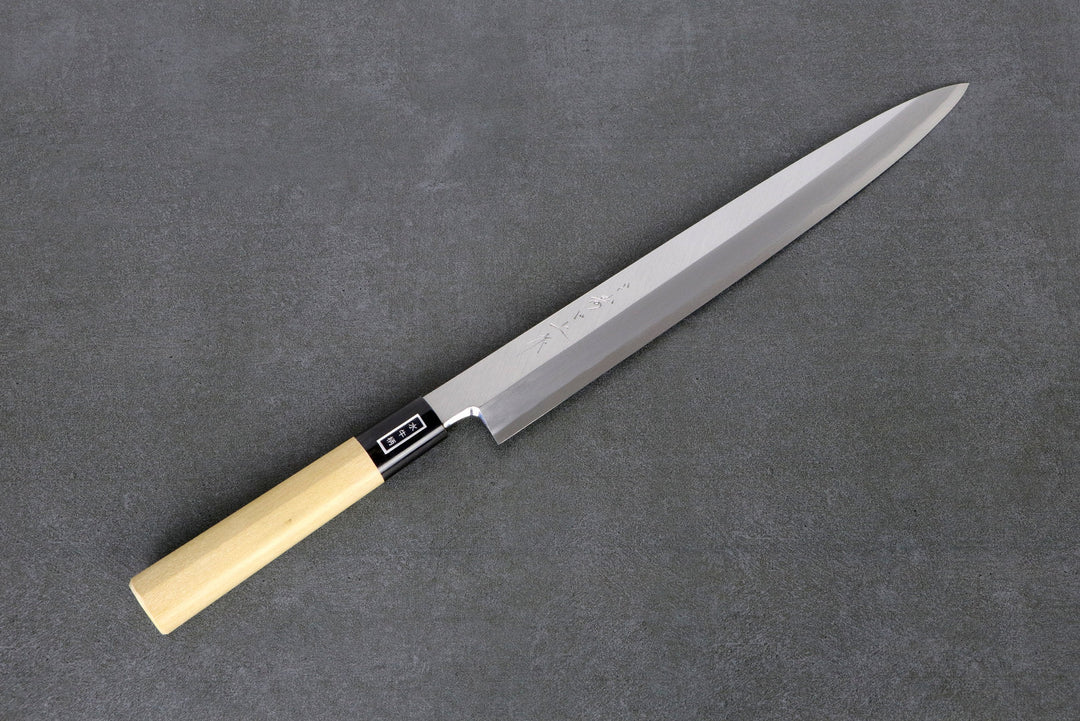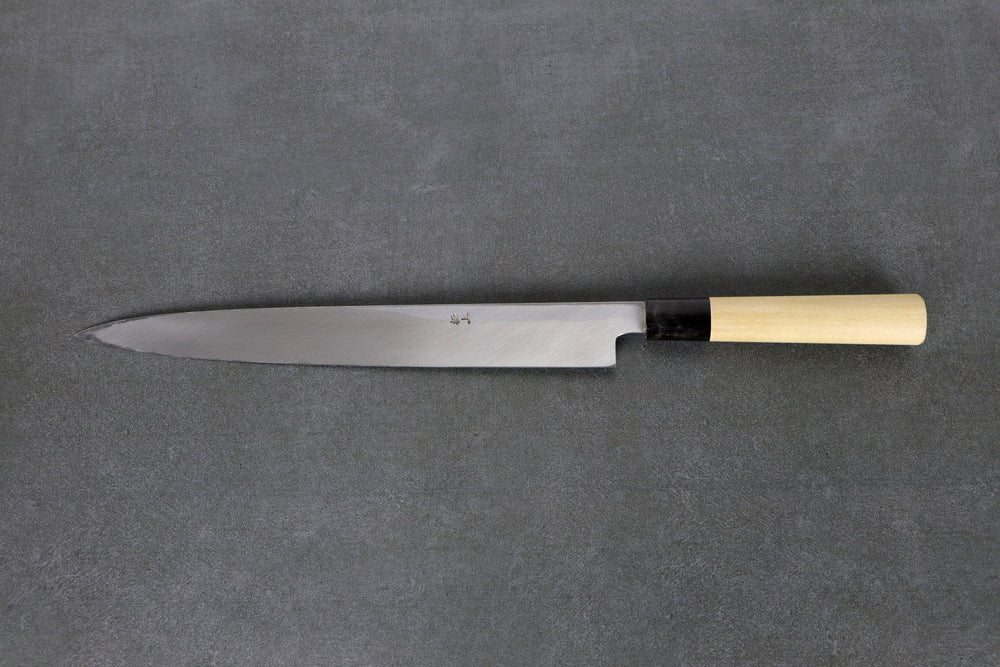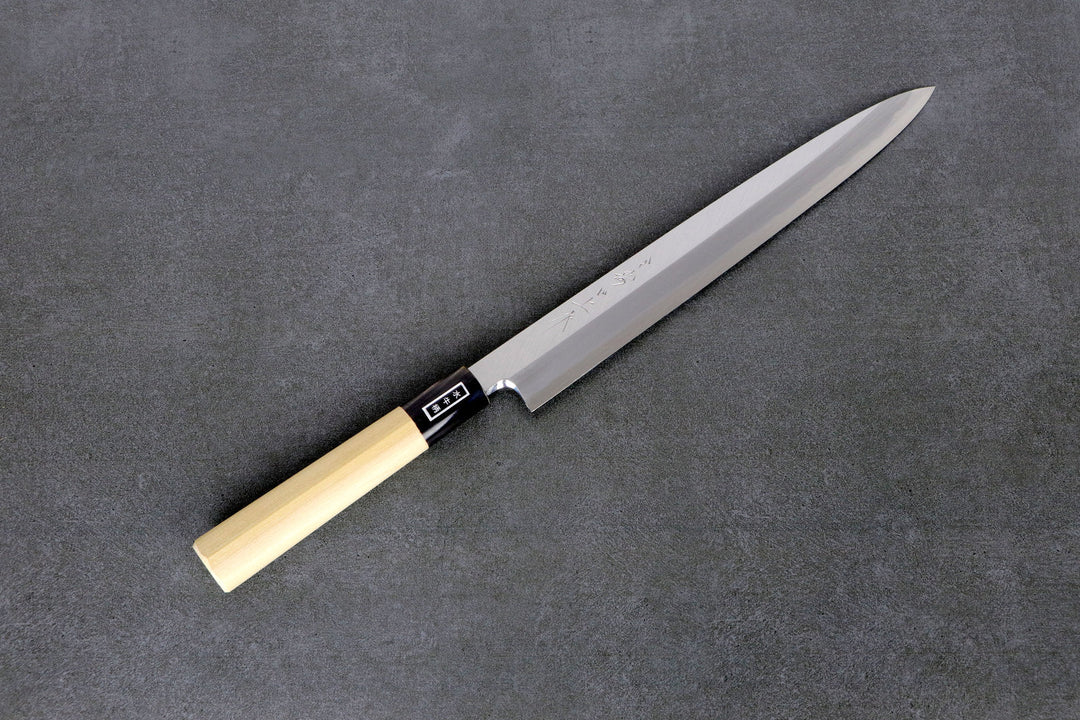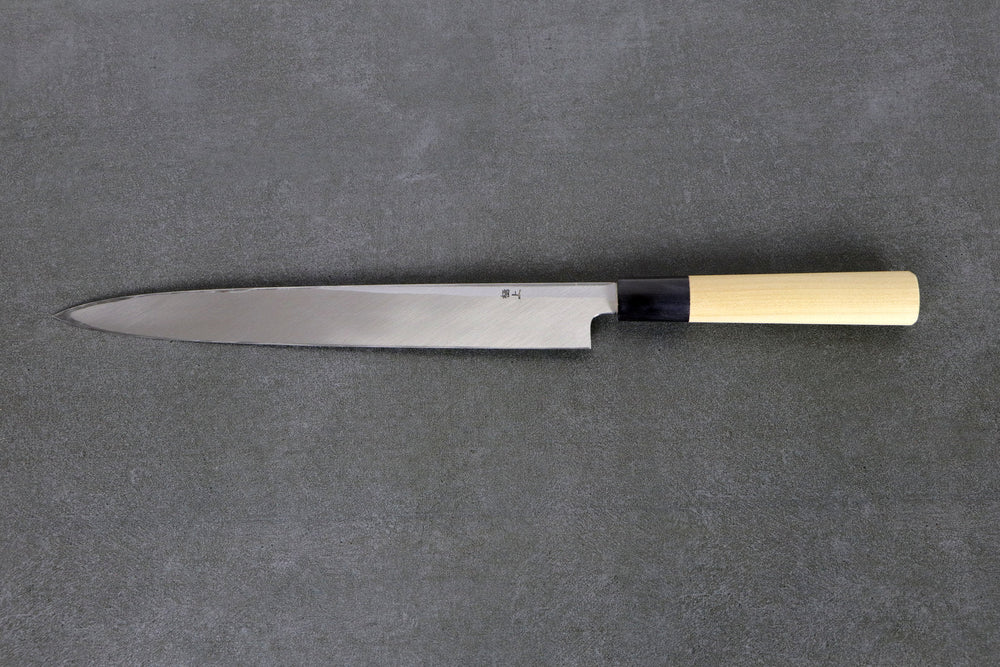A good sushi knife (also called Yanagiba knife) is a good choice for every lover of homemade sushi. Good sushi lives not only from the ingredients used, but also from the perfect preparation, and for that a Japanese sushi knife is the perfect tool.
What is a sushi knife?
In Japan, the sushi knife is one of the most important blade shapes and is correspondingly widespread. At the fish markets, yanagiba knives in a wide variety of sizes can be seen at every stall.
The sushi knife is often the most important tool of the fishmongers there, next to the deba knife. It is particularly important to them to handle the blades with care, so that a sushi knife is often used and preserved there for decades.
What does a sushi knife look like?
The sushi knife has a long and fairly straight blade. It resembles the shape of a small samuarai sword. Of course, this comparison is a bit vague, but you can see certain similarities.
The reason for the long and relatively narrow blade lies in the application when cutting. Through a smooth cutting motion in just one stroke, fish can be filleted perfectly. Thus, sashimi and fish for sushi can be perfectly portioned. The sujuhiki knife also has a similar blade shape, although the sujihiki or ham knife does not have such a straight blade.
How to prepare sashimi yourself?
In order to prepare sashimi and sushi yourself, you need good kitchen tools in the form of knives in addition to high quality fish. Without a good sushi knife with a clean edge, it is not possible to fillet fish.
Dull knives affect the sushi quality
Dull and poor knives will not finely divide the fish fillet, but will tear the fish flesh. This looks unappetizing on the one hand, and amateur and professional chefs will also notice a difference in taste.
Blunt knives affect food quality
A sharp blade on a sushi knife or chef's knife helps prevent food from losing liquid. Due to the single-edged blade, the Yanagiba fish knife can get an extreme sharpness when sharpened with a whetstone.
How long does the Japanese sushi knife stay sharp?
Original Japanese knives, whether all-purpose knives like Santoku knives or special blades like the Sashimi knife have the advantage of the hardness of the knife steel. The hardness of a knife steel is measured in Rockwell (HRC).
For example, if a Shirogami or Aogami Yanagiba is used properly, it can have a long service life, which is clearly superior to European knives. It is this advantage that makes Japanese sushi knives a special product for the discerning chef.
The best knives for sushi in comparison
To cut sushi rolls precisely, a good kitchen knife should be available. Ideal is a yanagiba, also known as sushi knife or sashimi knife. This type of knife from Japan was designed for preparing fish. It is not a filleting knife, for that Deba knives, Funayuki and Petty knives are usually better suited.
Making sushi rolls yourself
If you want to make sushi rolls yourself, you usually need fish. First, the fish must be coarsely chopped with the Deba. Then the fish fillet can be exposed with the Funayuki or Petty. Subsequently, the fillet is portioned with the Yanagiba or Sashimi knife.
Cut whole fish with the sushi knife
With large fish, the Yanagiba is also used to divide the fish. Think here, for example, of the large tuna, where whole fillet pieces are separated. Here Santoku or other Japanese kitchen knives are by far not as suitable as the classic sushi knife Yanagiba.
Sushi knife for meat
The sushi knife can also be used for portioning meat. If a blade is needed, for the precise preparation of meat, the Yanagiba or Sushi knife can be used here.
Similar to the use of the filleting knife for sashimi, the meat is also cut into fine pieces for Korean BBQ. The sushi knife can therefore also be used for other areas.
Cutting with the sushi knife
The sushi knife has a special blade shape that should be used optimally when cutting. The long blade with the one-sided grinding is designed for the preparation of fish. Not necessarily as a filleting knife, but tends to be a fish knife. Often falls the term sashimi knife, which is so okay, correct would also be Yanagiba.
Pulling cuts for perfect sushi
When cutting with this kitchen knife, the blade is pulled through the fillet in a long dragging motion. The blade has a high hardness for Japanese sushi knives, which is measured in Rockwell. This allows the blade to be ground very sharp and the blade has great characteristics.
This is exactly why the sashimi knife is so widely used in Japan and leaves little room for European products.
Sushi knife with one-sided grinding
As a rule, the Japanese Yanagiba is ground on one side (Attention: mostly only suitable for right-handers!), this allows for a high blade stability. The extremely smooth backs of sushi knives ensure that there is hardly any friction when cutting. This allows for very smooth cuts, which makes the cut fish or sushi look perfectly prepared.
Long Yanagiba blades for clean cuts
The blade length on a typical sushi knife is usually at least 240mm. This contributes to the fact that you do not have to move the blades back and forth when cutting, but can cut the fish or sushi with a continuous movement. This results in perfectly prepared sushi dishes.
However, the Japanese Yanagiba can be used to prepare not only raw fish. The Japanese Yanagiba knife can also be excellently used for processing pieces of meat into fine slices.
BUYING A SUSHI KNIFE, WHAT TO CONSIDER
Customers who are thinking of buying a yanagiba need to include the steel of the blade, the length of the blade, the handle and the quality of workmanship as criteria in the purchase decision.
SUSHI KNIFE BLADE LENGTH
The deciding factor here is how large the food to be processed in the kitchen is. Since the sashimi knife is rather unsuitable for vegetables, it should only be used for fish and meat. Blade lengths over 30 cm are then more for professional chefs or special businesses in which fish is processed.
There is no European counterpart to the Yanagiba. Only the ham knife is similar to the Yanagiba in some respects, although there is also a special Japanese meat knife, the Sujihiki.
SUSHI KNIFE STEEL
When it comes to steel, the decision has to be made whether it should be stainless steel or carbon-based knife steel. This also defines the preference between steel hardness and susceptibility to rust. Simply put, high rust susceptibility due to high carbon content goes hand in hand with higher hardness.
Stainless steel, on the other hand, is softer, but also hardly rusts at all. Steel hardness, which is measured in Rockwell, can be rated as hard from 61 HRC and as extremely hard from 64 Rockwell.
SUSHI KNIFE HANDLE
When it comes to the handle, a choice should be made between wood and synthetic materials such as plastic. Furthermore, the shape of the handle should be chosen. Here there is the classic Japanese handle and the European, also called western handle.
SUSHI KNIFE PRICE
Last but not least, the price must be right. A sashimi knife can quickly have a price of several hundred euros, because the blade shape is rather rare and a lot of craftsmanship of the manufacturer or forge is required for production.
SASHIMI KNIFE - THE CORRECT HANDLING
The correct handling of the sashimi knife must be learned. Since this knife usually has a longer blade than the Santoku or Gyuto, the correct cut must be learned. The knife also usually has a one-sided grind. Therefore, the majority of sashimi knives are not suitable for left-handers.
Special knives with a grinding for left-handers are of course also available, but less often. Therefore, please pay a little more attention to the grind when buying.
SUSHI KNIFE AND PRACTICE RESULT IN GOOD SUSHI
The task of finely cutting fish or sashimi requires skill and precision and the right knife. A santoku will do for certain tasks, but not as well as the sashimi knife.
The special blade shape and the bevel allow the knife to glide through the fillet. With little pressure, the knife can be pulled or pushed. It is important not to pull back and forth as with a saw, but to make long even cuts. This allows the sashimi knife to best utilize its strengths such as the bevel, the length of the blade and the carbon steel of the blade.
WHERE TO BUY SASHIMI KNIVES
The Yanagiba is not so popular in Europe and therefore more difficult to obtain than other chef's knives. Therefore, the selection of stores in Europe or retailers from which customers can obtain these knives is small. If there are also wishes such as special wood on the handle or special features of the product, it can be difficult to find the right knife. If you are also left-handed, the choice becomes even smaller. As a right-handed person, you have a greater choice in terms of handle, color, blade, equipment such as sheath for storage and manufacturer.
SUSHI KNIVES FROM SILVERBACK KNIVES
Sashimi knives at Silverback Knives come from Japan directly from the manufacturer. We offer products which are not available at Amazon, because they are small series. From us, via the shopping cart the knives come directly to your home. The number of knives in our store varies, depending on price and availability. So we are constantly expanding the items for sashimi in the store, paying attention to the details of each knife.
CUT SASHIMI PERFECTLY
In addition to the knife, of course, the fish to fillet must be a pleasure. You can either use a ready fillet for sashimi or fillet a fish yourself. Filleting is best done with Funayuki or Deba knives.
Once you have prepared the fillet, you can start on a wooden board or a special plastic cutting board. The sashimi should be cut finely, but not too thin. The knife is applied and pulled through the fillet with a little pressure. The one-sided grind allows for maximum precision and the sashimi is cut perfectly.
If the sashimi is served on rice it is an ideal morsel. Sashimi should be served bite-sized and should not have to be cut again on the plate.
CARE OF SASHIMI KNIVES
Since knives for sashimi are very large, sometimes there is a sheath to protect the blade with it. Alternatively, the box of delivery also goes for storage. Above all, the regular care of the knife for sashimi should be observed.
Also the sharpening of the blade must be restored regularly. Sashimi knives are not easy to grind and the sharpening is sometimes complicated. Therefore, it may be worthwhile to have the knife sharpened by experts. Names and addresses for such services of such a knife can be found online.





